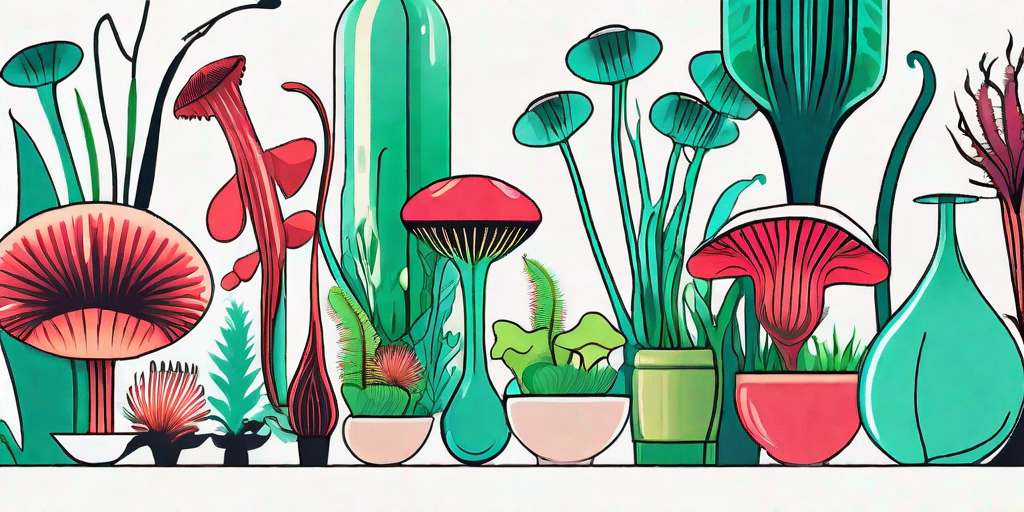
Welcome to the fascinating, and slightly macabre, world of carnivorous plant gardens. If you've ever fancied yourself a bit of an Audrey II from 'Little Shop of Horrors', or just have an affinity for the peculiar, then this is the place for you. Let's dive into the meaty (pun intended) details of these intriguing plants and how to cultivate your very own carnivorous garden.
Understanding Carnivorous Plants
What are Carnivorous Plants?
Before you start imagining a Venus Flytrap chomping down on a cheeseburger, let's clarify what we mean by 'carnivorous plants'. These are plants that derive some or most of their nutrients from trapping and consuming animals or protozoans, typically insects and other arthropods. Carnivorous plants have adapted to grow in places where the soil is thin or poor in nutrients, especially nitrogen, such as acidic bogs and rock outcroppings.
There are over 800 known species of carnivorous plants, each with their unique trapping mechanisms. Some, like the Venus Flytrap, use snap traps, while others like the Sundew, use sticky flypaper traps. Then there are the pitcher plants with pitfall traps, and bladderworts with suction traps. It's a real smorgasbord of insect-catching techniques.
Why are Carnivorous Plants Fascinating?
Well, for starters, they eat bugs. If that's not enough to pique your interest, these plants also have a unique aesthetic appeal. Their unusual shapes, vibrant colors, and intricate trapping mechanisms make them a captivating addition to any garden. Plus, there's something inherently cheeky about a plant that turns the tables on the animal kingdom.
Moreover, carnivorous plants are a testament to the incredible adaptability of nature. They've evolved these complex trapping mechanisms to survive in nutrient-poor environments, which is a remarkable feat. So, not only are they interesting to look at, but they also tell a fascinating story of survival and adaptation.
Creating Your Carnivorous Plant Garden
Choosing the Right Plants
When starting your carnivorous plant garden, the first step is to choose the right plants. Some popular choices include the Venus Flytrap, Sundew, Pitcher Plant, and Butterwort. Each of these plants has its unique care requirements, so it's essential to choose plants that are suitable for your environment and gardening skills.
For beginners, the Venus Flytrap is a great choice. It's relatively easy to care for and its jaw-like snap traps provide endless entertainment. For those looking for a challenge, the Sundew, with its glistening dew-covered tentacles, can be a rewarding choice.
Providing the Right Environment
Once you've chosen your plants, the next step is to create the right environment for them. Carnivorous plants typically require a humid environment, plenty of sunlight, and nutrient-poor soil. Yes, you read that right. While most plants thrive in nutrient-rich soil, carnivorous plants have adapted to poor soil conditions. So, hold off on the fertilizer for these guys.
Most carnivorous plants also require a dormant period during the winter months. During this time, the plants will appear to die back, but don't worry, they're just taking a nap and will bounce back in the spring.
Feeding Your Carnivorous Plants
What to Feed
Despite the name, carnivorous plants don't require a diet of steak and potatoes. In fact, most carnivorous plants will do just fine with a diet of insects. If you're keeping your plants indoors, you might need to supplement their diet with small insects like flies or ants. But remember, these plants are adapted to a low-nutrient diet, so don't overfeed them.
Also, never feed your plants human food or fertilizers. These can harm or even kill your plants. Stick to insects and let your plants do what they do best.
How to Feed
Feeding your carnivorous plants can be as simple as letting nature take its course. If your plants are outdoors, they'll likely catch enough insects on their own. For indoor plants, you might need to play the role of the hunter. You can catch small insects and place them on the plant's traps.
Remember, these plants aren't pets. They don't need to be fed daily or even weekly. In fact, overfeeding can be harmful. A good rule of thumb is to feed your plants once every 2-3 weeks.
Frequently Asked Questions
Do Carnivorous Plants Eat Humans?
Despite what Hollywood might have you believe, carnivorous plants pose no threat to humans. The largest known carnivorous plant, the Giant Montane Pitcher Plant, is only capable of trapping small rodents. So, unless you're a bug or a very small mouse, you're safe.
Can I Grow Carnivorous Plants Indoors?
Absolutely! Many carnivorous plants can be grown indoors, provided they get plenty of sunlight and humidity. Just remember to keep them away from curious pets and children.
Do Carnivorous Plants Need Soil?
Yes, but not just any soil. Carnivorous plants prefer a nutrient-poor, acidic soil mix. A common mix is one part peat moss to one part perlite or sand.
Conclusion
There you have it, a comprehensive guide to the world of carnivorous plant gardens. These fascinating plants offer a unique gardening experience and a chance to observe nature's adaptability up close. So, why not take a walk on the wild side and start your own carnivorous plant garden? Just remember, these plants bite back!















